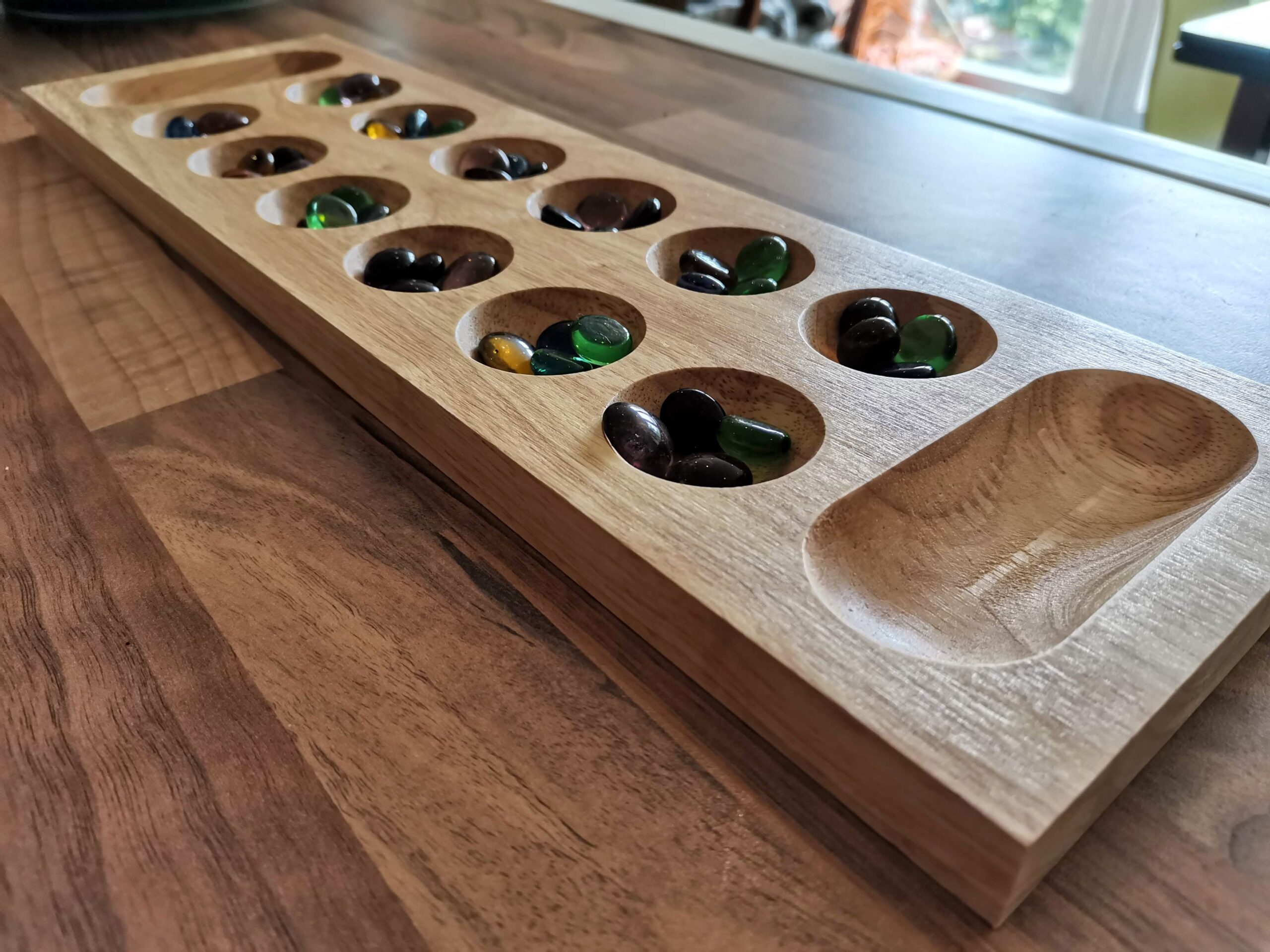Call Of Kilforth Review
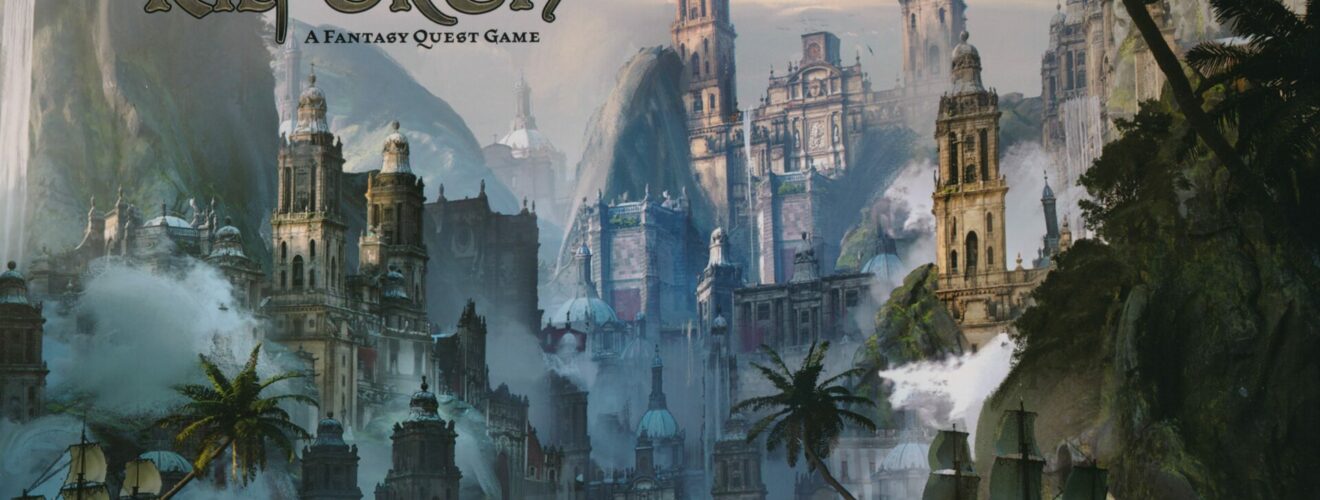
Back to Kilforth, for glory and adventure! Or, in my case, for the first time, because I haven’t played either of the previous Kilforth games, namely Gloom of or Shadow of. Call of Kilforth is a fantasy adventure with a hint of gothicy piratism (definitely real words) thrown in for good measure, which you and your gang can either play competitively or cooperatively. Using cards to represent the world means that designer Tristan Hall has created a game where the world is different every time you play it, which you could fit inside the likes of Gloomhaven 10 times and still have room for more. It turns out that less is more, and Call of Kilforth does all of the things I like in a fantasy game while avoiding plenty of pitfalls.
Going on a Saga holiday
The core concept behind Call of Kilforth is a glorified pick-up-and-deliver style of game, but to reduce it to such a thing would be doing it a massive disservice. The world (i.e. a 5×5 grid of location cards) is randomised to start with and the heroes venture out from the center location: Rimeshore Port. From there, the world is your oyster. You can set out in any direction, doing whatever you want to. To help keep the player on some kind of leash, regardless of how loose it may be, each hero has a few different things to give them something to aim for. Each has a race, a class, and most importantly of all, a saga.
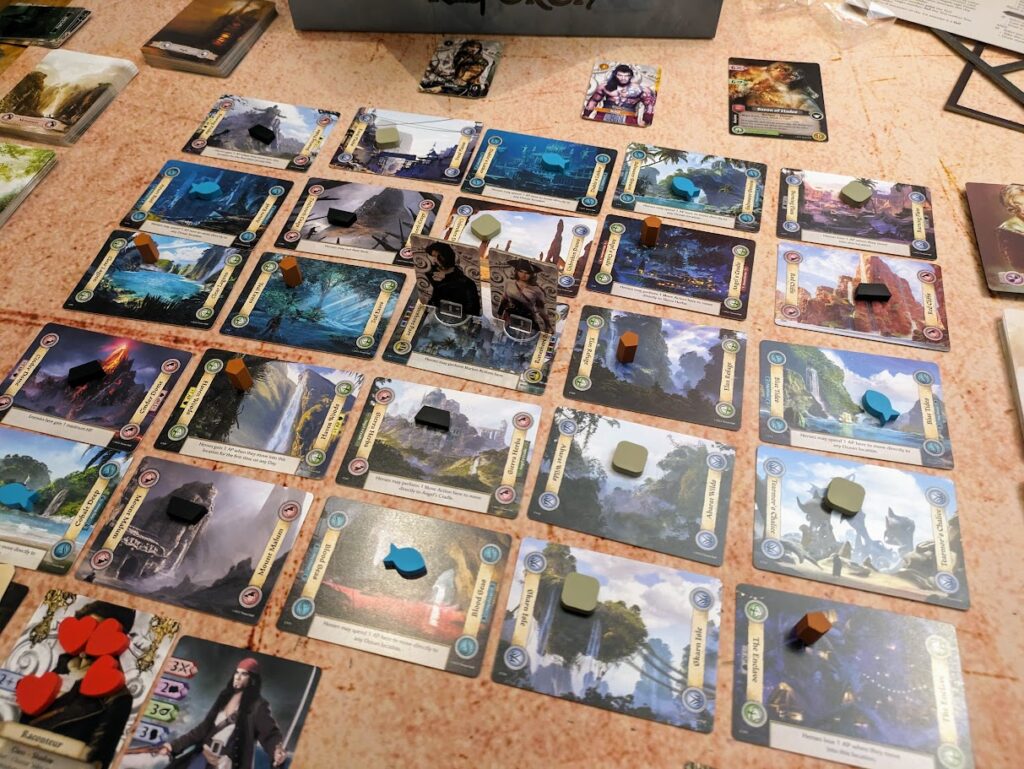
The sagas are the cleverest part of the design in my opinion. While you can assign a saga based on a character’s class (which the rules suggest you do on your first play), there’s nothing to stop you throwing caution to the wind and randomising all three things. It’s great because it means not only is the world’s layout different each time, changing where you need to go to collect goods and fulfill quests, but also the way you go about accomplishing things changes too. Your race and class might align to turn you into an intellectual glass cannon, as stupid and charismatic as a steroid-fuelled troll, but a force to be reckoned with when it comes to fisticuffs.
Sagas are essentially mini-books consisting of a few cards, and by collecting assets and rumours on their travels, the players can flip a page and continue their stories, working their way toward a final showdown against the boss of their saga. I say final, but in truth, it’s like fighting the boss before the boss. The Ganondorf before the Ganon, if you will. Completing a saga finale brings the game’s Ancient to the world (or Ancients, plural, in a co-op game), the big bad-ass whose defeat signals the end of the game. It’s a juicy bit of compressed narrative that keeps all the players invested in what’s going on, and while it might not rival the 100+ hour campaigns of bigger games, that’s not necessarily a bad thing.
Pick up and deliverance
So the story bit is there, the reason for you to want to do anything in the first place, but what’s it actually like to play? It’s a lot of fun as it happens, and immediately familiar if you’ve played some of the Forbidden (Island, Desert) games. The whole idea of spending some of your action points to move to a named or type of location card, to collect a thing or fulfill another thing, it’s comfortable. It’s putting on a favourite sweater and enjoying how it feels. The same goes for flipping a location to its bad side. It’s a nice comparison to use to draw more casual gamers into your new fantasy purchase. “Remember Forbidden Island? That game we played that comes in a tin? Yeah, it’s a bit like that”.
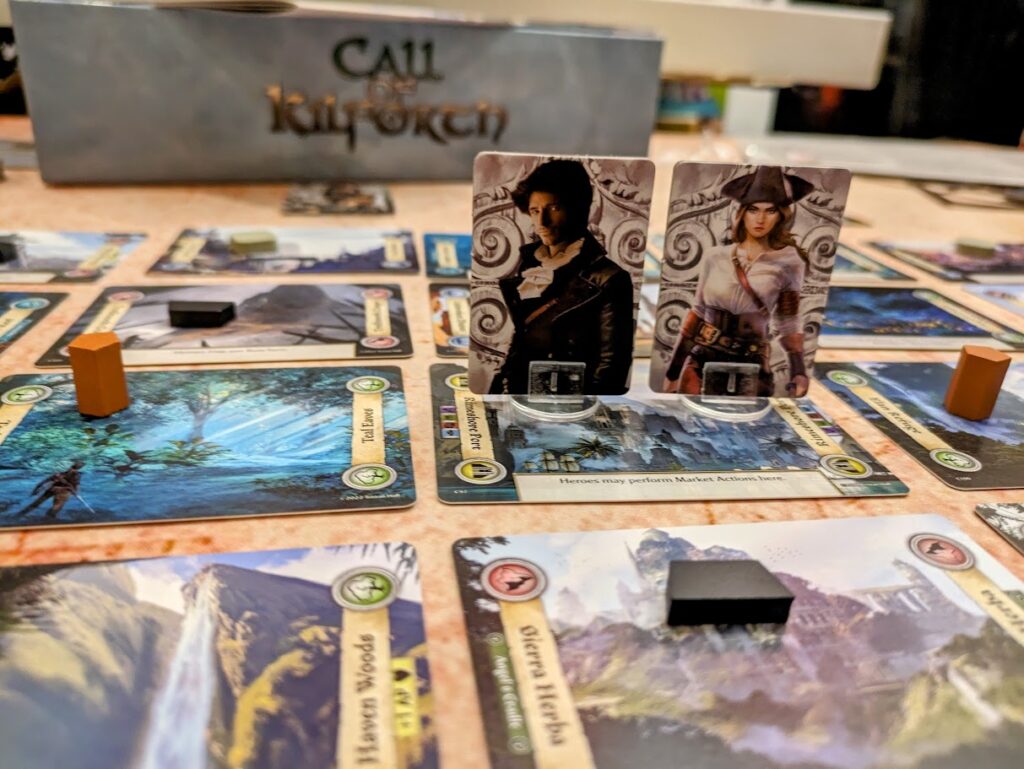
The thing most likely to throw a spanner in the proverbial works is the amount of keywords. They’re everywhere, and not always in one specific place. Luckily, the rulebook does a great job of explaining them, but on your first couple of plays, you’ll want it on hand to refer to. Speaking of the rulebook, while I found it a bit disjointed at times, I have to give them kudos for including a proper index at the back. When I play a game like this where I can pick up the paper copy, look at the back, and it tells me which page to look at, it makes me wonder why more games don’t do it. It’s much nicer than having to download a PDF copy and use ctrl+f to find the thing you’re looking for.
There’s a forced pace to the game, which might not appeal to everyone, but works in its favour for me. Each round of the game is played out over a day and a night phase, and each night forces one of the locations to flip to its Gloom side. Gloom’s bad, unless you particularly enjoy losing HP for ending a day somewhere gloomy, like Eeyore’s basement. Trust me, you don’t want this, especially when you consider that your number of actions for each day is tied to your HP. 4 HP means 4 action points, all of which area precious, especially when there are eight things you want to do each day.
Making the most of your available actions is undeniably the crux of doing well. You’ll be bouncing all over the map, carrying out quests, revealing places, and fighting bad guys, all while trying to collect the things you need to complete said quests before you even think about cracking on through your saga. You’ll collect stuff to help you along the way like items, titles, and spells, but it can still feel like a tall order.
Final thoughts
Right at the top of this review, I mentioned how I like the things Call of Kilforth does and the things it omits. I should put some context around that. As much as I want to think of myself as someone who wants to immerse myself in high fantasy campaigns that take hundreds of hours, the truth is that I’m not that person. The set-up and tear-down times alone can be bad enough before I even think about finding a group to take it all on with, and then wringing the necessary hours out of my already demanding schedule. Hallelujah then, for a game that gives me my fantasy questing fix in a couple of hours, then all goes back in a box that takes up a small space on my shelves. Not forcing me into a huge campaign means if I forget what happened the last time I played, it doesn’t make a blind bit of difference.
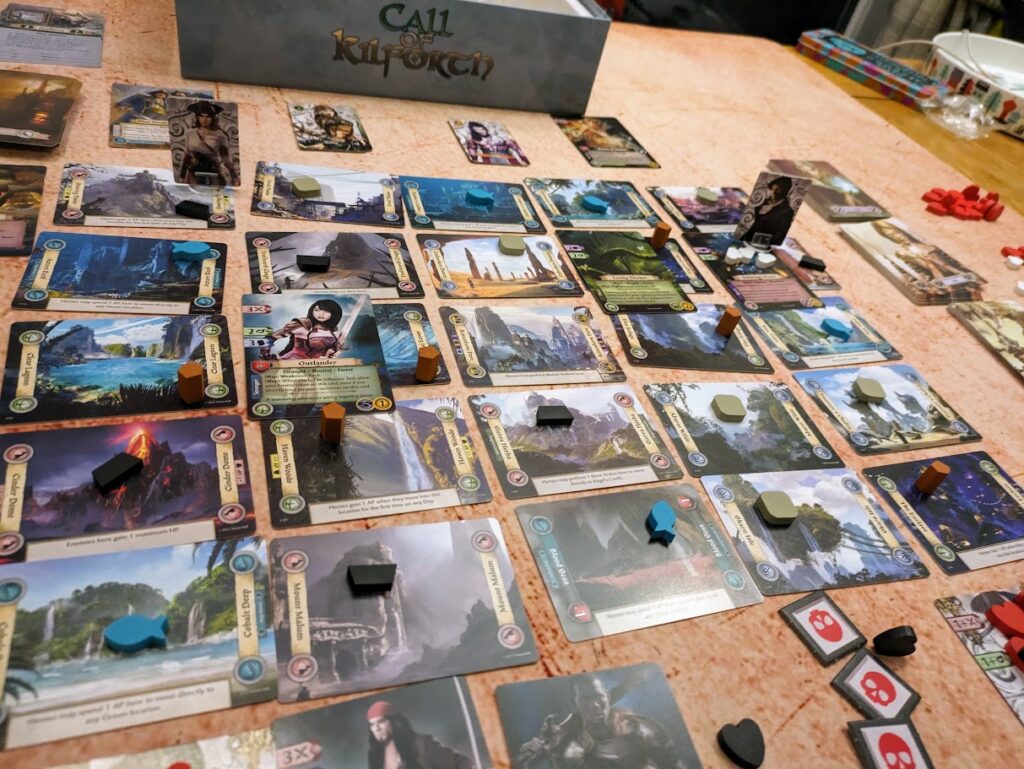
That said, there’s a fair amount of terminology to contend with when you first play. Make no mistake, this isn’t as light a crawl as something like Bag of Dungeon (review here). There’s still plenty here to get your teeth stuck into. The rulebook runs to 28 pages (and includes at least one Monkey Island quote, which instantly wins favour with me). Within a couple of plays though you’ll innately know what the game terms mean. For example, ‘Veiling’ a card is the equivalent of ‘tapping’, rotating it 90 degrees to indicate that it’s spent. Once you’re familiar with the basic game, there’s plenty in the box to keep things interesting. Outposts, Galleons, Plots, Ancient Abilities all get thrown into the mix to give you more to think about and to contend with. World of Darkness mode is especially challenging, starting the game with every location on its Gloom side, asking the players to spend gold to bring light to the world.
Co-op isn’t really my thing, so I can’t comment on that too much, but in terms of a competitive and solo game, Call of Kilforth is great. It gives you that fantasy hit without asking too much in return, and it does it with style. As I’ve come to expect from Hall Or Nothing’s games now, the artwork throughout is gorgeous, and the writing is rich with lore and character. Kilforth is clearly a very real place in the minds of Tristan and the people who play his games, so the fan service on offer along with the continued world-building is appreciated. Some might bemoan the lack of a board for their £50 investment, but with similarly-priced competitors like Jaws of the Lion asking you to play on a book, it’s really not a big deal.
Quick, thematic, no-fuss fantasy from a designer who really knows his world. I probably ought to try the other two Kilforth games now…
Review copy kindly provided by Hall or Nothing Productions. Thoughts and opinions are my own.
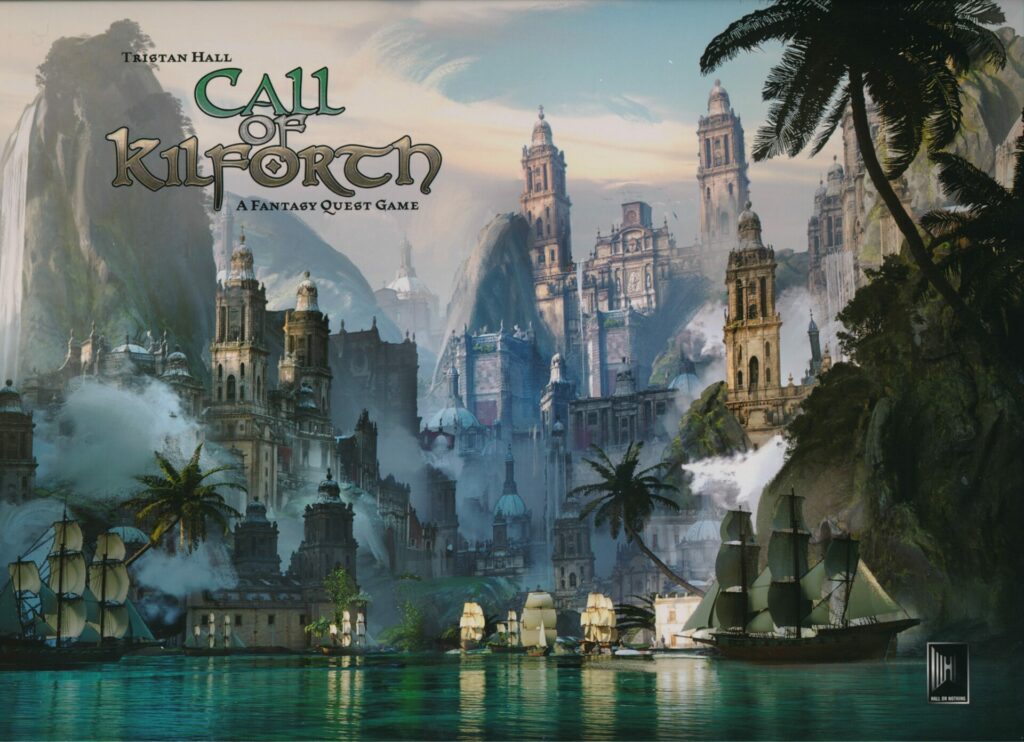
Call of Kilforth (2023)
Design: Tristan Hall
Publisher: Hall or Nothing Productions
Art: The Creation Studio, Jose Del Nido, Mikhail Greuli, Wietze Fopma, Roman Hodek, Ania Kryczkowska, Carlos Villas
Players: 1-4
Playing time: 45-180 mins









